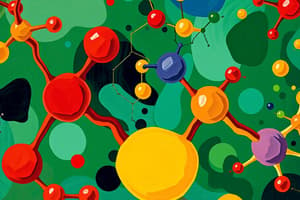Podcast
Questions and Answers
What color change would indicate a positive result for a Benedict's test?
What color change would indicate a positive result for a Benedict's test?
- Orange (correct)
- Brick Red (correct)
- Green/Yellow
- Blue
What color change would indicate a positive result for a Biuret's test?
What color change would indicate a positive result for a Biuret's test?
- Orange
- Green/Yellow
- Purple (correct)
- Blue
What color change would indicate a positive result for the Iodine test?
What color change would indicate a positive result for the Iodine test?
- Clear
- Orange/Brown
- Blue/Black (correct)
- Blue
What color change would indicate a positive result for the Emulsion test?
What color change would indicate a positive result for the Emulsion test?
Which test is used to detect the presence of simple sugars like glucose?
Which test is used to detect the presence of simple sugars like glucose?
Which of the following is a positive result for the Benedict's test for glucose?
Which of the following is a positive result for the Benedict's test for glucose?
What is the purpose of grinding a food sample in a pestle and mortar before testing it?
What is the purpose of grinding a food sample in a pestle and mortar before testing it?
What is the purpose of shaking the test tube with ethanol in the emulsion test for lipids?
What is the purpose of shaking the test tube with ethanol in the emulsion test for lipids?
What is the correct order of steps for performing the Iodine test for starch?
What is the correct order of steps for performing the Iodine test for starch?
What is the correct order of steps for performing the Biuret test for protein?
What is the correct order of steps for performing the Biuret test for protein?
Which of the following tests is used to detect the presence of simple sugars, such as glucose?
Which of the following tests is used to detect the presence of simple sugars, such as glucose?
Which biological molecule is detected by the Biuret test?
Which biological molecule is detected by the Biuret test?
What is the main purpose of the water bath in the Benedict's test?
What is the main purpose of the water bath in the Benedict's test?
Flashcards
Benedict’s Test
Benedict’s Test
A test to detect glucose in food samples using Benedict’s solution.
Iodine Test
Iodine Test
A test for starch in food samples that uses iodine solution and changes color.
Biuret’s Test
Biuret’s Test
A test used to identify proteins in food samples by observing color change with Biuret's solution.
Emulsion Test
Emulsion Test
Signup and view all the flashcards
Positive Benedict’s Result
Positive Benedict’s Result
Signup and view all the flashcards
Negative Benedict’s Result
Negative Benedict’s Result
Signup and view all the flashcards
Positive Biuret’s Result
Positive Biuret’s Result
Signup and view all the flashcards
Positive Iodine Result
Positive Iodine Result
Signup and view all the flashcards
Benedict's Test
Benedict's Test
Signup and view all the flashcards
Positive Result in Benedict's Test
Positive Result in Benedict's Test
Signup and view all the flashcards
Iodine Solution Test
Iodine Solution Test
Signup and view all the flashcards
Biuret's Test
Biuret's Test
Signup and view all the flashcards
Study Notes
Starter Activity - 5 Minutes
- List the tests for identifying biological molecules
- Glucose
- Starch
- Protein
- Lipids
- Bonus task: State the positive and negative results for each test.
Lesson - Testing an Unknown Sample
- Lesson Outcomes:
- Bronze: Recall different food tests.
- Silver: Complete four different food tests.
- Gold: Identify different biological molecules in the food.
Food Testing Procedure
- Prepare the food sample: Grind the food sample (e.g., bread) with water in a mortar and pestle.
- Filter the sample: Use filter paper to filter the ground food sample into a beaker.
- Add water and mix: In food testing procedures, add 5ml of water and mix the sample to prepare for further tests.
Food Testing Methods
- Glucose: Use test tubes and water baths.
- Starch: Use a spotting tile with iodine solution.
- Protein: Use a spotting tile with Biuret's solution.
- Lipids: Use test tubes for the emulsion test.
Glucose Test - Benedict's Test
- Purpose: To test for simple sugars (e.g., glucose).
- Procedure:
- Prepare a food sample.
- Add 5 mL of the food sample to a test tube.
- Add 5 mL of Benedict's solution and mix.
- Heat the test tube in a water bath at 80°C for 10 minutes.
- Record the colour change.
- Results:
- Negative (no glucose): Blue
- Low glucose concentration: Green/yellow
- Medium glucose concentration: Orange
- High glucose concentration: Brick red
Starch Test - Iodine Test
- Purpose: To test for starch.
- Procedure:
- Prepare a food sample.
- Place a small amount of the food sample on a spotting tile.
- Add 2-3 drops of iodine solution to the food sample.
- Observe the colour change.
- Results:
- Negative (no starch): Orange/brown
- Positive (starch present): Blue/black
Protein Test - Biuret Test
- Purpose: To test for protein.
- Procedure:
- Prepare a 5 mL sample of the food.
- Add 5 mL of Biuret's solution.
- Mix the solution thoroughly.
- Observe the colour change.
- Results:
- Negative (no protein): Blue
- Positive (protein present): Purple
Lipid Test - Emulsion Test
- Purpose: To test for lipids (fats).
- Procedure:
- Place a small amount of the food sample in a test tube.
- Add 5 mL of ethanol and shake to dissolve the lipid.
- Add 5 mL of water and mix the solution thoroughly.
- Observe the colour change.
- Results:
- Negative (no lipids): Clear solution
- Positive (lipids present): Cloudy white solution
Studying That Suits You
Use AI to generate personalized quizzes and flashcards to suit your learning preferences.




